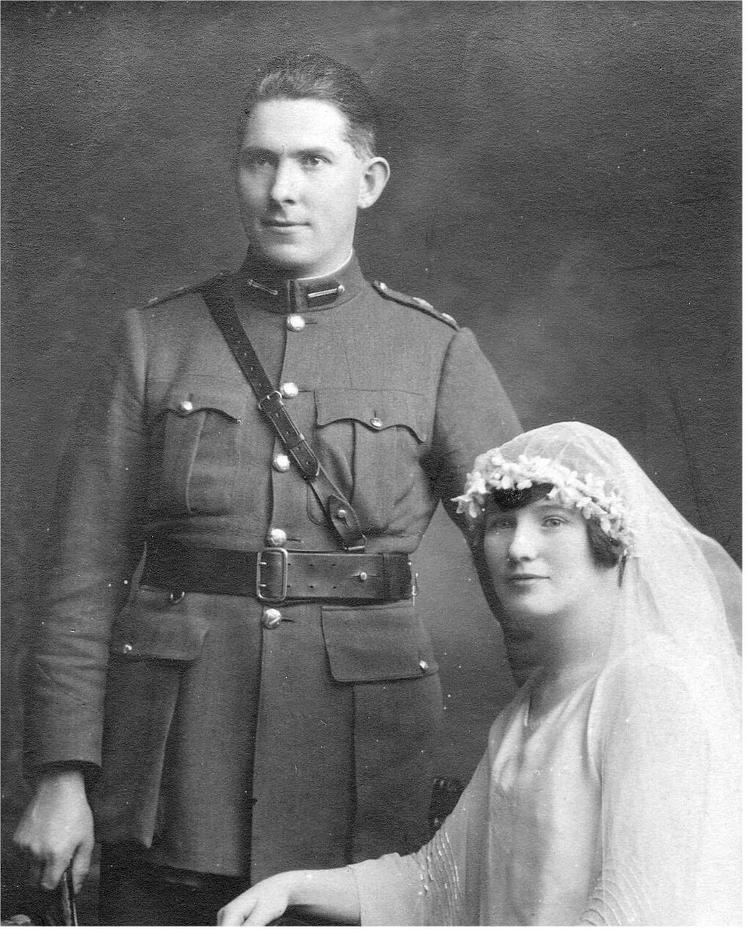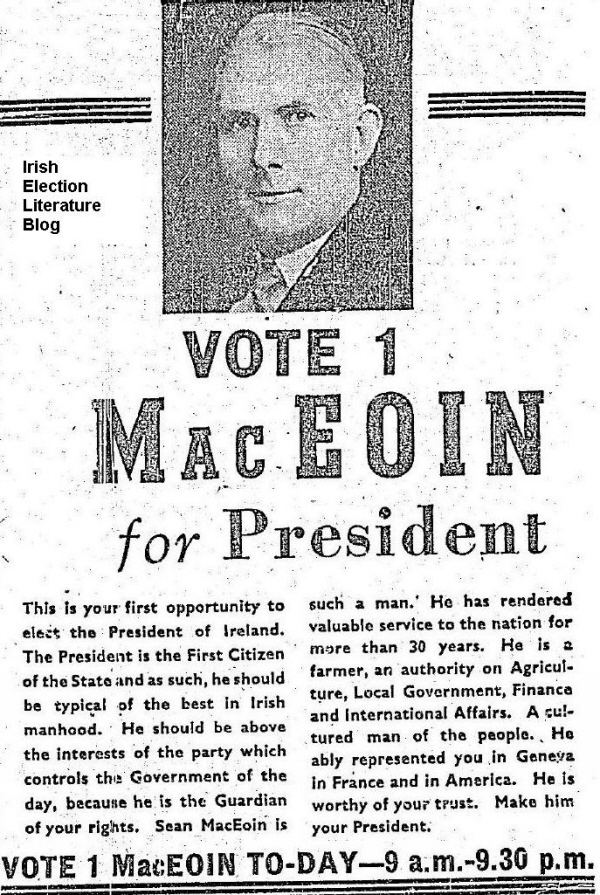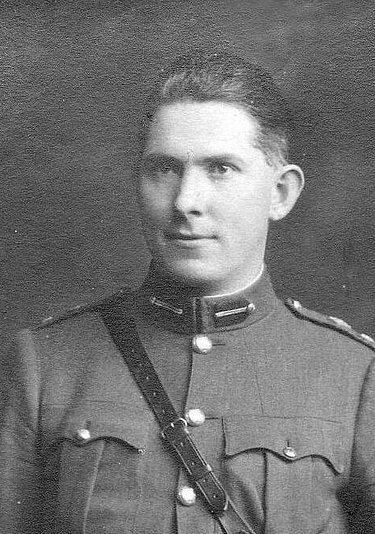Name Sean Eoin Role Politician | ||
Battles and wars | ||
Sean mac eoin clearing a road block
Seán Mac Eoin (30 September 1893 – 7 July 1973) was an Irish Fine Gael politician and soldier. He was commonly referred to as the "Blacksmith of Ballinalee".
Contents
- Sean mac eoin clearing a road block
- Early life
- IRA leader
- Treaty and the Civil War
- Political career
- House controversy
- References

Early life

Seán Mac Eoin was born John Joseph McKeon on 30 September 1893 at Bunlahy, Granard, County Longford, the eldest son of Andrew McKeon and Catherine Treacy. After a national school education he trained as a blacksmith in his father's forge and, on his father's death in February 1913, he took over the running of the forge and the maintenance of the McKeon family. He moved to Kilinshley, in the Ballinalee district, County Longford to set up a new forge.

His Irish nationalist activities began in earnest in the same year when he joined the Clonbroney Company of the Irish Volunteers and was sworn into the Irish Republican Brotherhood.
IRA leader

He came to prominence in the War of Independence as leader of an Irish Republican Army (IRA) flying column. In November 1920, he led the Longford brigade in attacking Crown forces in Granard during one of the periodic government reprisals, forcing them to retreat to their barracks. On 31 October RIC Inspector Philip St John Howlett Kelleher was shot dead in Kiernan's Greville Arms Hotel in Granard. The Auxiliaries set fire to parts of the town. MacEoin looked on helplessly as they went on the rampage. The next day, MacEoin held the village of Ballinalee situated on the Longford Road between Longford and Granard. They stood against superior British forces, forcing them to retreat and abandon their ammunition. In a separate attack on 8 November MacEoin led his men against the RIC at Ballinalee. An eighteen-year-old Constable Taylor was killed. Constable E Shateford and two others were wounded. The story was that the small garrison sang "God Save the King" as they took up positions to return fire.

On Wed, 2 February 1921, Longford IRA ambushed 18 ambushed on the road at Clonfin with a mine they had planted. Two lorries were involved, the first blown up, and the second strafed by rapid rifle fire. District Inspector Lt-Cmdr Worthington Craven was hit by two bullets and killed. District Inspector Taylor was shot in chest and stomach. At the Clonfin Ambush Mac Eoin ordered his men to care for the wounded British, at the expense of captured weaponry. This earned him both praise and criticism, but became a big propaganda boost for the war effort, especially in the United States. He was admired by many within the IRA for leading practically the only effective column in the midlands. In July 1920 he was among the majority of commanders who were prepared to sign the Agreement recognizing the volunteers as the Army of the Republic. The Oath of Allegiance was "for the purpose of ratifying under the Agreement under which the Volunteers came under the control of the Dail".

On the afternoon of 7 January 1921, A crown force (consisting of ten men-one officer and nine other soldiers) appeared on Anne Martin's street. McKeon's own testament at his trial (which was not contested by any parties present, including the 9 surviving soldiers) states that:- "I was at the table writing when I was informed of the advance of the party. My account books were left in this house for safety.I was in partial uniform, wearing Sam Bronwe belt and revolver with two Mills No. 4 bombs in my pocket. Owing to some females being in the house, I had to get out as I could not endanger them by putting up a defence in the house, and as this Officer and Police Force had already signified to my sister and mother their intention to shoot me on sight, I decided to give them a run for their money. I stepped out on the street, about three paces directly in front of the oncoming force, and opened fire with my revolver. The leading file fell, and then the second file in the gateway brought their rifles to the ready. I then threw a bomb, and jumped back behind the porch to let it burst. When it had burst and the smoke had lifted, I saw that the whole force had cleared away, save the officer who was dead or dying on the street." On 5 February, Anglo-Celt ran an article claiming the discovery of the body of William Chalmers, a local Protestant farmer. Mr Elliott was also a farmer, whose body was found on 30 January, lying face down in a bog.
He was captured at Mullingar railway station in March 1921, imprisoned and sentenced to death for the murder of an RIC Inspector.
Mac Eoin's family forge was near Currygrane, County Longford, the family home of Henry Wilson, the British CIGS. In June 1921 Wilson was petitioned for clemency by MacEoin's mother (who referred to her son as "John" in her letter), by his own brother Jemmy, and by the local Church of Ireland vicar, and passed on the appeals out of respect for the latter two individuals. Three auxiliaries had already given character references on his behalf after he had treated them chivalrously at the Clonfin Ambush in February 1921. However, Macready, British Commander-in-Chief, Ireland, confirmed the death sentence describing Mac Eoin as "nothing more than a murderer" and writing that he was probably responsible for other "atrocities", but also later recorded in his memoirs that Mac Eoin was the only IRA man he had met, apart from Collins, to have a sense of humour. His second-in-command was from North Roscommon. Sean Connolly had a colourful career as head of Leitrim brigade.
Mac Eoin wrote this poignant letter to his friend (and classmate at Moyne Latin School) Father Jim Sheridan, a combatant in the Old IRA and a "Flying Column" member who had been ordained and sent to Milwaukee to study theology:
According to Oliver St. John Gogarty, Charles Bewley wrote Mac Eoin's death-sentence speech. Michael Collins organised a rescue attempt. Six IRA Volunteers, led by Paddy O'Daly, captured a British armoured car and, wearing British Army uniforms, gained access to Mountjoy Prison. However, Mac Eoin was not in the part of the jail they believed, and after some shooting, the rescue party retreated.
Mac Eoin was eventually released from prison – along with all other members of the Dáil – after Collins threatened to break off treaty negotiations with London unless he was freed. It was rumoured that Sean Mac Eoin was to be the best man at Collins' wedding.
Treaty and the Civil War
In the debate on the Anglo-Irish Treaty Mac Eoin seconded Arthur Griffith's motion that it should be accepted.
Mac Eoin joined the National Army and was appointed GOC Western Command in June 1922. In the Irish Civil War, he pacified the west of Ireland for the new Free State, marching overland to Castlebar and linking up with a seaborne expedition that landed at Westport. For the rest of the 1920s his military career was a steady upward curve: he was appointed GOC Curragh Training Camp in August 1925, Quartermaster General in March 1927, and Chief of Staff in February 1929. His tenure of the highest post in the armed forces would not appear to have been a particularly happy period and his departure came in June 1929.
Political career
In 1929 he resigned from the Army and was elected at a by-election to Dáil Éireann for the Leitrim–Sligo constituency. At the 1932 general election he moved to the constituency of Longford–Westmeath and served the Longford area as TD in either Longford–Westmeath (1932–37, 1948–65) or Athlone–Longford (1937–48) until he was defeated at the 1965 general election.
During a long and distinguished political career he served as Minister for Justice (February 1948 – March 1951) and Minister for Defence (March–June 1951) in the First Inter-Party Government, and again as Minister for Defence (June 1954 – March 1957) in the Second Inter-Party Government.
He unsuccessfully stood twice as candidate for the office of President of Ireland, against Seán T. O'Kelly in 1945, and Éamon de Valera in 1959.
MacEoin retired from public life after the 1965 general election and died on 7 July 1973. He married Alice Cooney on 21 June 1922 at a ceremony attended by Griffith and Collins, she died on 16 February 1985. They had no children.
House controversy
There is currently a controversial plan to demolish his home, Rose Cottage in Balinalee, County Longford, and replace it with ten houses. This house served as his headquarters during the Battle of Balinalee in 1920. The plan is facing local opposition from historical groups and residents.
A modified plan for the site which includes the existing dwelling with non-original extensions removes is applied for by the County Leitrim owned developers.
